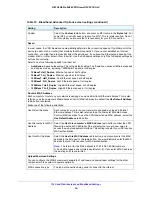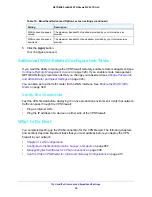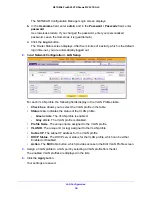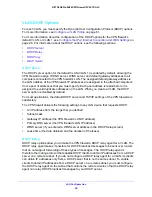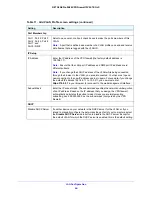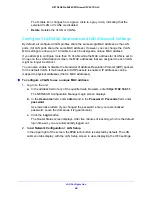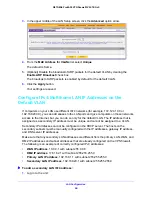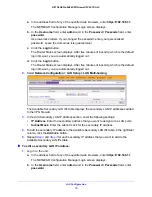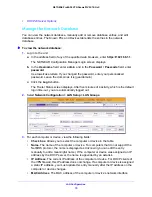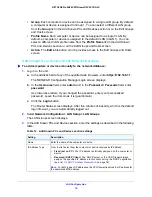
LAN Configuration
60
NETGEAR ProSAFE VPN Firewall FVS318G v2
VLAN DHCP Options
For each VLAN, you must specify the Dynamic Host Configuration Protocol (DHCP) options.
For more information, see
Configure a VLAN Profile
on page 61.
For more information about the configuration of the DHCP options for the VPN firewall’s
default VLAN, or VLAN 1, see
Configure the IPv4 Internet Connection and WAN Settings
on
page 26.
For information about the DHCP options, see the following sections:
•
DHCP Server
•
DHCP Relay
•
DNS Proxy
•
LDAP Server
DHCP Server
The DHCP server option for the default VLAN (VLAN 1) is enabled by default, allowing the
VPN firewall to assign IP, DNS server, WINS server, and default gateway addresses to all
computers connected to the VPN firewall’s LAN. The assigned default gateway address is
the LAN address of the VPN firewall. IP addresses are assigned to the attached computers
from a pool of addresses that you must specify. Each pool address is tested before it is
assigned to avoid duplicate addresses on the LAN. When you create a VLAN, the DHCP
server option is disabled by default.
For most applications, the default DHCP server and TCP/IP settings of the VPN firewall are
satisfactory.
The VPN firewall delivers the following settings to any LAN device that requests DHCP:
•
An IP address from the range that you defined
•
Subnet mask
•
Gateway IP address (the VPN firewall’s LAN IP address)
•
Primary DNS server (the VPN firewall’s LAN IP address)
•
WINS server (if you entered a WINS server address in the DHCP Setup screen)
•
Lease time (the date obtained and the duration of the lease)
DHCP Relay
DHCP relay options allow you to make the VPN firewall a DHCP relay agent for a VLAN. The
DHCP relay agent makes it possible for DHCP broadcast messages to be sent over routers
that do not support forwarding of these types of messages. The DHCP relay agent is
therefore the routing protocol that enables DHCP clients to obtain IP addresses from a DHCP
server on a remote subnet. If you do not configure a DHCP relay agent for a VLAN, its clients
can obtain IP addresses only from a DHCP server that is on the same subnet. To enable
clients to obtain IP addresses from a DHCP server on a remote subnet, you must configure
the DHCP relay agent on the subnet that contains the remote clients so that the DHCP relay
agent can relay DHCP broadcast messages to your DHCP server.









